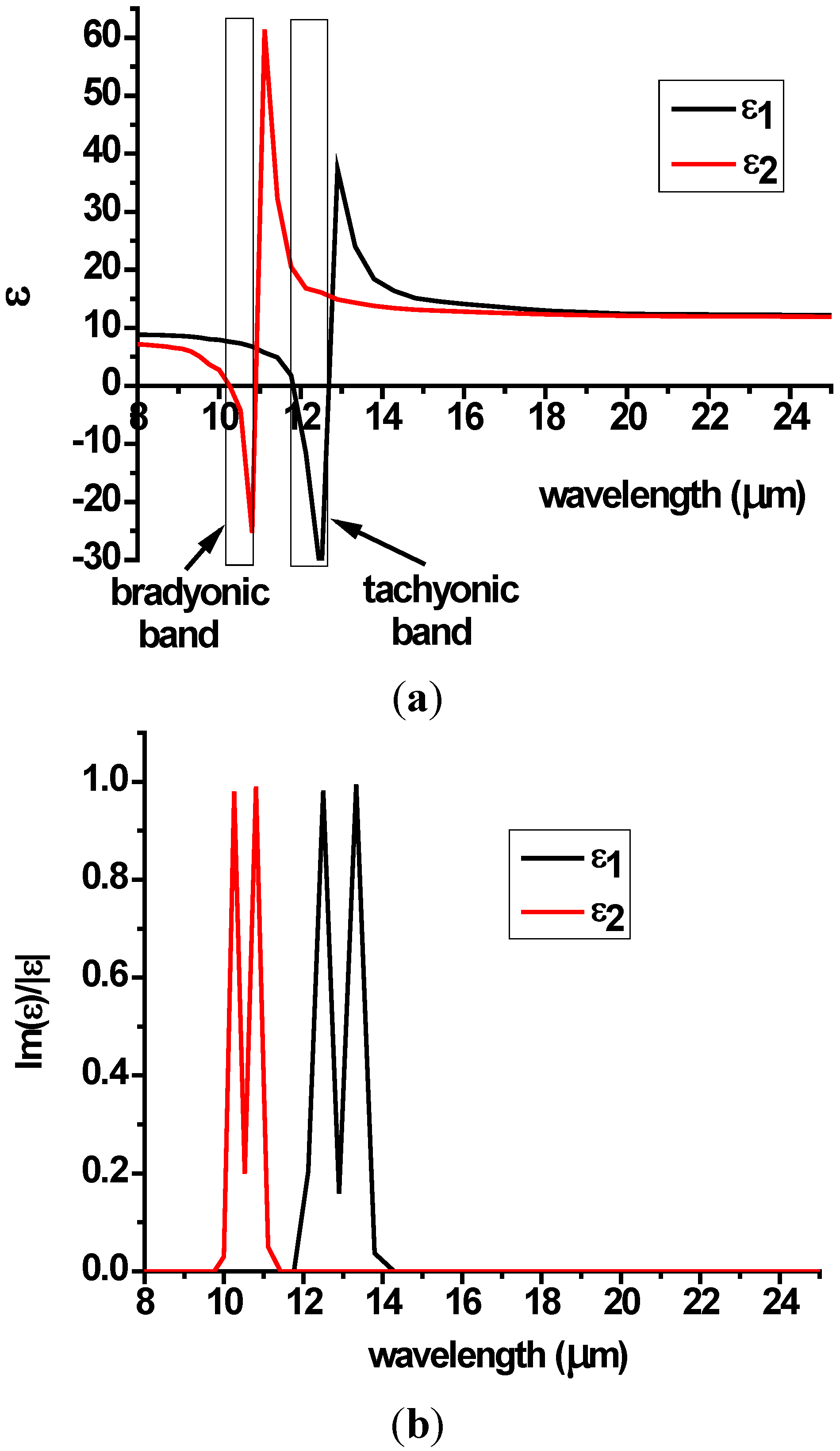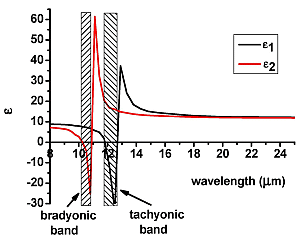2. Results and Discussion
Before we proceed to a model of interacting tachyonic fields, let us recall basic properties of hyperbolic metamaterials and their description using effective 2 + 1 dimensional Minkowski spacetime. Recent advances in electromagnetic metamaterials enable design of novel physical systems which can be described by effective space-times having very unusual metric and topological properties [
15]. In particular, hyperbolic metamaterials (see
Figure 1) offer an interesting experimental window into physics of Minkowski spacetimes, since propagation of extraordinary light inside a hyperbolic metamaterial is described by wave equation exhibiting 2 + 1 dimensional Lorentz symmetry. A detailed derivation of this result can be found in [
9,
10]. Assuming that the metamaterial in question is uniaxial and non-magnetic, electromagnetic field inside the metamaterial may be separated into ordinary and extraordinary waves: vector
![Galaxies 02 00072 i019]()
of the extraordinary light wave is parallel to the plane defined by the k–vector of the wave and the optical axis of the metamaterial. In the frequency domain (in some frequency band around ω = ω
0) the metamaterial may be described by anisotropic dielectric tensor having opposite signs of the diagonal components ε
xx = ε
yy = ε
1 and ε
zz = ε
2, while all the non-diagonal components are assumed to be zero in the linear optics limit. Propagation of extraordinary light in such a metamaterial may be described by a coordinate-dependent wave function φ
ω =
Ez obeying the following wave equation [
9,
10]:
If ε
1 > 0 while ε
2 < 0, this wave equation coincides with the Klein-Gordon equation for a massive scalar field φ
ω in 3D Minkowski spacetime:
in which spatial coordinate
z = τ behaves as a “timelike” variable. Equation (5) describes world lines of massive particles obeying “relativistic” dispersion law:
(see
Figure 1c) which propagate in a flat 2 + 1 dimensional Minkowski spacetime. The wave vector component
kz plays the role of effective energy, while vector
(kx,
ky) plays the role of momentum. The effective mass squared
m*2 appears to be positive. Note that components of metamaterial dielectric tensor define the effective metric
gik of this spacetime:
g00 = ε
1 and
g11 =
g22 =
−ε
2. This spacetime may be made “causal” by breaking the mirror and temporal symmetries of the metamaterial, which results in one-way light propagation along the timelike spatial coordinate [
16], while “gravitational bending” of the effective spacetime may lead to an experimental model of the big bang [
10]. In the weak gravitational field limit the effective Einstein equation:
is reduced to:
where ϕ is the gravitational potential [
17]. Since
z coordinate plays the role of time, while
g00 is identified with –ε
1, Equation (8) must be translated as:
where ∆
(2) is the 2D Laplacian operating in the
xy plane, γ* is the effective “gravitational constant”, and σ
zz is the
zz component of the Maxwell stress tensor of the electromagnetic field in the medium [
18]:
Figure 1.
Typical geometries of hyperbolic metamaterials: (a) metal wire array structure, and (b) multilayer metal-dielectric structure. The role of time in the effective 3D Minkowski spacetime is played by z coordinate aligned with the optical axis of the metamaterial, while kz behaves as an effective “energy”; depending on frequency range and materials used, both configurations may exhibit either bradyonic or tachyonic dispersion relations shown in (c).
Figure 1.
Typical geometries of hyperbolic metamaterials: (a) metal wire array structure, and (b) multilayer metal-dielectric structure. The role of time in the effective 3D Minkowski spacetime is played by z coordinate aligned with the optical axis of the metamaterial, while kz behaves as an effective “energy”; depending on frequency range and materials used, both configurations may exhibit either bradyonic or tachyonic dispersion relations shown in (c).
Detailed analysis performed in [
8] indicates that nonlinear corrections to ε
1 due to Kerr effect lead to effective gravitational interaction between the extraordinary photons, and the sign of the third order nonlinear susceptibility χ
(3) of the hyperbolic metamaterial must be negative for the effective gravity to be attractive. It is also interesting to note that in the strong gravitational field limit this model contains 2 + 1 dimensional black hole analogs in the form of subwalength solitons [
8].
Let us analyze how the basic framework outlined above can be extended to the tachyonic case. Very recently it has been noted [
19] that depending on the frequency range and materials used, extraordinary photons in both hyperbolic metamaterial configurations shown in
Figure 1a,b may exhibit a tachyonic dispersion relation. Let us analyze solutions of Equation (4) in the case where ε
1 < 0 while ε
2 > 0. It is clear that extraordinary photon propagation through such a metamaterial may still be described using an effective 2 + 1 dimensional Minkowski spacetime. However, the effective metric coefficients
gik of this spacetime change to
g00 = ε
1 and
g11 = g22 = ε
2, and the dispersion law of extraordinary photons changes to:
(see
Figure 1c) where extraordinary photons acquire tachyonic imaginary effective mass
iμ*. It is easy to verify that Equations (4) and (11) lead to correct sign of the trace of the effective 2 + 1 dimensional energy momentum tensor
Teffik which coincides with the Maxwell stress tensor:
The contributions to σ
ik which are made by a single extraordinary plane wave propagating inside the hyperbolic metamaterial may be calculated similar to [
8]. Assuming without a loss of generality that the
B field of the wave is oriented along
y direction, the other field components may be found from Maxwell equations as:
Taking into account the dispersion law Equation (11) of the extraordinary wave, the contributions to σ
zz and σ
xx from a single plane wave are:
while σ
yy = 0, leading to tachyonic negative
TrTeff=−
B2/4π.
Similar to [
8], nonlinear optical Kerr effect leads to gravity-like self-interaction of the tachyonic field. Taking into account that
g00 = ε
1, the Einstein Equation (8) translates into:
where γ* is the effective “gravitational constant”. For a single plane wave Equation (15) may be rewritten as:
where the nonlinear corrections to ε
1 are assumed to be small, so that we can separate ε
1 into the constant background value ε
1(0) and weak nonlinear corrections (note that similar to [
8], second order nonlinear susceptibilities χ
(2)ijl of the metamaterial are assumed to be zero). These nonlinear corrections look like the Kerr effect assuming that the extraordinary photon wave vector components are large compared to ω
/c:
This assumption has to be the case if extraordinary photons may be considered as classic “particles”. Equation (17) establishes connection between the effective gravitational constant γ* and the third order nonlinear susceptibility χ
(3) of the hyperbolic metamaterial. Similar to the “bradyonic case” considered in [
8], the sign of χ
(3) must be negative for the effective gravity to be attractive (since ε
2 > 0). Since most liquids exhibit large and negative thermo-optic coefficient resulting in large and negative χ
(3), and there exist readily available ferrofluid-based hyperbolic metamaterials [
20], laboratory experiments with gravitationally self-interacting tachyonic fields appear to be realistic in the near future. Moreover, as we will demonstrate below, even more curious case of coexisting mutually-interacting tachyonic and bradyonic fields seems to be no more difficult to realize. Since gravitational dynamics of mutually interacting tachyonic and bradyonic fields may have contributed to inflation and late time acceleration of our universe [
3,
5], such experiments would be very interesting.
Let us consider a multilayer metal-dielectric metamaterial shown in
Figure 1b. The diagonal components of its dielectric tensor may be obtained using Maxwell-Garnett approximation [
21]:
where
n is the volume fraction of the metallic phase (assumed to be small), and ε
m and ε
d are the dielectric permittivities of the metal and dielectric phase, respectively. A suitable choice of
n is known to lead to hyperbolic behavior in such metamaterials [
21]. However, ordinary metals cannot be used in a hyperbolic metamaterial design having closely spaced tachyonic and bradyonic frequency bands due to their broadband metallic (ε
m < 0) behavior. This difficulty may be overcome by using such materials as SiC, which have narrow Restsrahlen metallic bands in the long wavelength infrared (LWIR) range. Silicon carbide may be used in combination with such material as Si, which exhibits broadband dielectric behavior in the LWIR having ε
d ~ 10.9. Indeed, our calculations presented in
Figure 2 indicate that around
n ~ 0.3 a multilayer SiC-Si metamaterial does have pronounced closely spaced tachyonic and bradyonic frequency bands, while having relatively low losses. The calculated values of ε
1 and ε
2 are based on the measured optical properties of SiC reported in [
22]. A somewhat similar result has been reported in [
21] for a SiC-Si wire array structure, but unlike our multilayer design, fabrication of SiC-Si wire arrays may prove extremely difficult. We should also point out that such materials as SiO
2, Al
2O
3,
etc. also have pronounced Restsrahlen bands in the LWIR range, so that they can be used in the layered design with equal success. If native undoped Si is used in the metamaterial design, its nonlinearity will be dominated by negative thermo-optic coefficient due to thermal expansion. Thus, the desired negative χ
(3) metamaterial will be obtained resulting in positive γ
*.
We should also point out that ε and χ
(3) tensors of the metamaterial do not need to stay coordinate independent. Spatial behavior of the dielectric permittivity tensor components may be engineered so that the background metric may closely emulate metric of the universe during inflation [
23]. On the other hand, engineered higher order nonlinear susceptibility terms χ
(n) may be used to emulate the desired functional form of the tachyonic potential
V(ϕ) (see Equations (1–3)). As a result, various scenarios of tachyonic inflation [
3] will become amenable to direct experimental testing.
Figure 2.
(a) Calculated diagonal components of the dielectric permittivity tensor of a multilayer SiC-Si metamaterial in the long wavelength infrared (LWIR) frequency range. The volume fraction of SiC equals n = 0.3. Two closely spaced tachyonic and bradyonic hyperbolic bands arise near λ = 11 μm; (b) Calculated Im(ε)/|ε| for both directions indicate low loss hyperbolic behavior inside the bands.
Figure 2.
(a) Calculated diagonal components of the dielectric permittivity tensor of a multilayer SiC-Si metamaterial in the long wavelength infrared (LWIR) frequency range. The volume fraction of SiC equals n = 0.3. Two closely spaced tachyonic and bradyonic hyperbolic bands arise near λ = 11 μm; (b) Calculated Im(ε)/|ε| for both directions indicate low loss hyperbolic behavior inside the bands.



 of the extraordinary light wave is parallel to the plane defined by the k–vector of the wave and the optical axis of the metamaterial. In the frequency domain (in some frequency band around ω = ω0) the metamaterial may be described by anisotropic dielectric tensor having opposite signs of the diagonal components εxx = εyy = ε1 and εzz = ε2, while all the non-diagonal components are assumed to be zero in the linear optics limit. Propagation of extraordinary light in such a metamaterial may be described by a coordinate-dependent wave function φω = Ez obeying the following wave equation [9,10]:
of the extraordinary light wave is parallel to the plane defined by the k–vector of the wave and the optical axis of the metamaterial. In the frequency domain (in some frequency band around ω = ω0) the metamaterial may be described by anisotropic dielectric tensor having opposite signs of the diagonal components εxx = εyy = ε1 and εzz = ε2, while all the non-diagonal components are assumed to be zero in the linear optics limit. Propagation of extraordinary light in such a metamaterial may be described by a coordinate-dependent wave function φω = Ez obeying the following wave equation [9,10]:






















